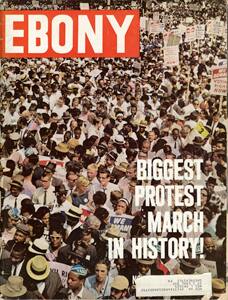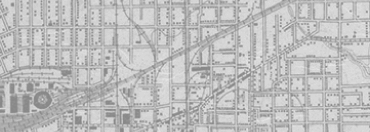


Back
Ebony magazine from November 1963
Ebony magazine from November 1963 (pre-assassination) featuring a photograph of a huge crowd of protesters and the title "BIGGEST PROTEST MARCH IN HISTORY!" The publisher's note about the cover image states: "In recognition of the significance of the March on Washington, this month's cover features some of the estimated 250,000 participants of the already historic event. Fittingly, the nation's largest rights pilgrimage also provided EBONY with the largest number of persons ever to appear on its cover. Photograhped by G. Marshall Wilson, the cover represents part of a unique mass undertaking by the entire Johnson Publishing Co. photo staff, which was on hand to capture for our readers many unforgettable moments of [sic] gigantic event (see story starting on Page 29)."Cover story begins: "BIGGEST PROTEST MARCH: 250,000 jam Washington for huge civil rights demonstration." The story is accompanied by both color and black and white photographs of the March on Washington.This image is not available online larger than a thumbnail to protect the copyright of its creator(s). For a more detailed examination of this item, please schedule an appointment in the Museum’s Reading Room.
Ebony magazine from November 1963
November 1963
Paper
13 1/4 × 10 in. (33.7 × 25.4 cm)
The Sixth Floor Museum at Dealey Plaza Collection
2014.062.0001
Ebony magazine was a pictorial news magazine that first appeared in November 1945. Created by John H. Johnson, it was modeled after LIFE magazine, another popular, mainstream pictorial magazine of the time. Ebony celebrated African American life and culture by depicting the achievements of black Americans. During the late 1950s the magazine ran Dr. Martin Luther King, Jr.’s column, “Advice for Living By.” During the 1960s, articles supporting and covering civil rights appeared as the magazine provided a national platform for addressing the racial issues affecting African Americans. - Krishna Shenoy, Librarian/Archivist
The March on Washington for Jobs and Freedom called for civil and economic rights for African Americans. Approximately 250,000 Americans marched on the mall in Washington D.C., on Tuesday, August 27, 1963. On Wednesday, August 28, 1963, Martin Luther King, Jr., standing in front of the Lincoln Memorial, delivered his historic "I Have a Dream" speech, in which he called for an end to racism. Along with Dr. King’s speech, the legacy of the march lives on in the Civil Rights Act (1964) and the Voting Rights Act (1965). - Krishna Shenoy, Librarian/Archivist

Ebony magazine from November 1963
Ebony magazine from November 1963 (pre-assassination) featuring a photograph of a huge crowd of protesters and the title "BIGGEST PROTEST MARCH IN HISTORY!" The publisher's note about the cover image states: "In recognition of the significance of the March on Washington, this month's cover features some of the estimated 250,000 participants of the already historic event. Fittingly, the nation's largest rights pilgrimage also provided EBONY with the largest number of persons ever to appear on its cover. Photograhped by G. Marshall Wilson, the cover represents part of a unique mass undertaking by the entire Johnson Publishing Co. photo staff, which was on hand to capture for our readers many unforgettable moments of [sic] gigantic event (see story starting on Page 29)."Cover story begins: "BIGGEST PROTEST MARCH: 250,000 jam Washington for huge civil rights demonstration." The story is accompanied by both color and black and white photographs of the March on Washington.This image is not available online larger than a thumbnail to protect the copyright of its creator(s). For a more detailed examination of this item, please schedule an appointment in the Museum’s Reading Room.
Ebony magazine from November 1963
November 1963
Civil rights
Protests
March on Washington
Magazines
EBONY
Paper
13 1/4 × 10 in. (33.7 × 25.4 cm)
The Sixth Floor Museum at Dealey Plaza Collection
2014.062.0001
Ebony magazine was a pictorial news magazine that first appeared in November 1945. Created by John H. Johnson, it was modeled after LIFE magazine, another popular, mainstream pictorial magazine of the time. Ebony celebrated African American life and culture by depicting the achievements of black Americans. During the late 1950s the magazine ran Dr. Martin Luther King, Jr.’s column, “Advice for Living By.” During the 1960s, articles supporting and covering civil rights appeared as the magazine provided a national platform for addressing the racial issues affecting African Americans. - Krishna Shenoy, Librarian/Archivist
The March on Washington for Jobs and Freedom called for civil and economic rights for African Americans. Approximately 250,000 Americans marched on the mall in Washington D.C., on Tuesday, August 27, 1963. On Wednesday, August 28, 1963, Martin Luther King, Jr., standing in front of the Lincoln Memorial, delivered his historic "I Have a Dream" speech, in which he called for an end to racism. Along with Dr. King’s speech, the legacy of the march lives on in the Civil Rights Act (1964) and the Voting Rights Act (1965). - Krishna Shenoy, Librarian/Archivist









